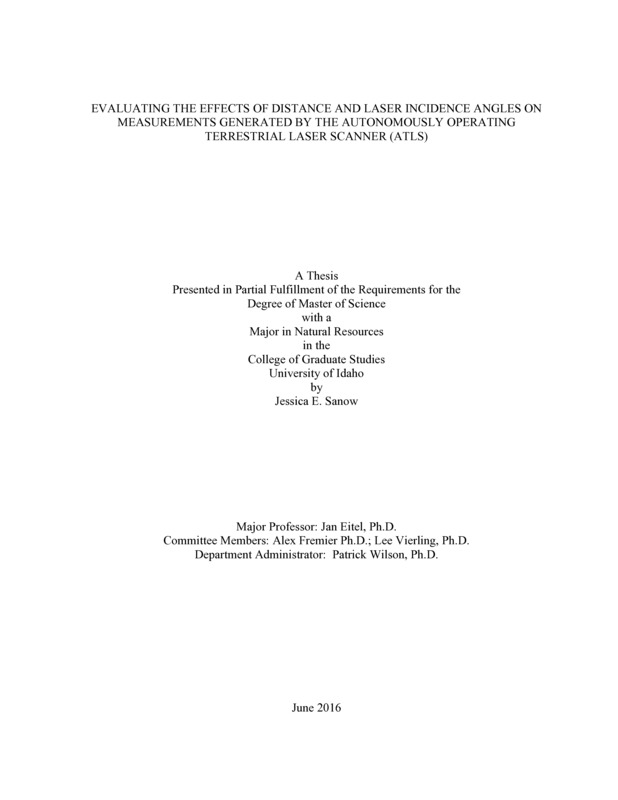EVALUATING THE EFFECTS OF DISTANCE AND LASER INCIDENCE ANGLES ON MEASUREMENTS GENERATED BY THE AUTONOMOUSLY OPERATING TERRESTRIAL LASER SCANNER (ATLS)
Sanow, Jessica. (2016). EVALUATING THE EFFECTS OF DISTANCE AND LASER INCIDENCE ANGLES ON MEASUREMENTS GENERATED BY THE AUTONOMOUSLY OPERATING TERRESTRIAL LASER SCANNER (ATLS). Theses and Dissertations Collection, University of Idaho Library Digital Collections. https://www.lib.uidaho.edu/digital/etd/items/sanow_idaho_0089n_10965.html
- Title:
- EVALUATING THE EFFECTS OF DISTANCE AND LASER INCIDENCE ANGLES ON MEASUREMENTS GENERATED BY THE AUTONOMOUSLY OPERATING TERRESTRIAL LASER SCANNER (ATLS)
- Author:
- Sanow, Jessica
- Date:
- 2016
- Keywords:
- ATLS LiDAR SNOTEL Snow depth measurements TLS
- Program:
- Natural Resources
- Subject Category:
- Environmental science; Hydrologic sciences
- Abstract:
-
Snow depth measurements are critical in avalanche studies, ecology, snow water equivalent measurements, disaster risk assessment, water budget models, climate models, and cryosphere studies. Light Detection and Ranging (LiDAR) based Terrestrial Laser Systems (TLS) have proven capable to generate 3D scans providing information regarding snow depth measurements. However, these scans typically have low temporal resolution data scans and are high in cost (>$40,000 USD). The Autonomously Operating Terrestrial Laser Scanner (ATLS) is a unique system that can generate high temporal resolution data scans at a low cost and has the potential to be used for snow depth studies in locations that are unsafe or inaccessible to humans throughout the winter season, although, this data has not yet been validated. Scans produced by ATLS were studied to quantify the effects of laser incidence angles and distances to determine if ATLS is capable of producing high quality, accurate snow depths. To complete the validation, the specific objectives are to test how ATLS snow depth measurements are affected by the 1) distance between the laser and the surface and 2) angle of incidence. Overall, the study found that the ATLS was capable of generating data with only a marginally significant effect due to distance and angles (p = 0.07). RMSD values found from the study were rather high, ranging from 2.56 to 6.55 cm and these errors could drastically alter results of a study. It was found that at distances 10-20 meters from the ATLS can result in a snow depth error of 5.98% and at distances 30-40 meters an error of 4.03%. These errors seem small, but when applied over an entire 100 m2 watershed can result in a 10.44 m3 (2,757 gallons) over or underestimation of water. Several external factors could be the cause of these errors and future studies are needed to fully explore these issues.
- Description:
- masters, M.S., Natural Resources -- University of Idaho - College of Graduate Studies, 2016
- Major Professor:
- Eitel, Jan
- Committee:
- Fremier, Alex; Vierling, Lee
- Defense Date:
- 2016
- Identifier:
- Sanow_idaho_0089N_10965
- Type:
- Text
- Format Original:
- Format:
- application/pdf
- Rights:
- In Copyright - Educational Use Permitted. For more information, please contact University of Idaho Library Special Collections and Archives Department at libspec@uidaho.edu.
- Standardized Rights:
- http://rightsstatements.org/vocab/InC-EDU/1.0/

